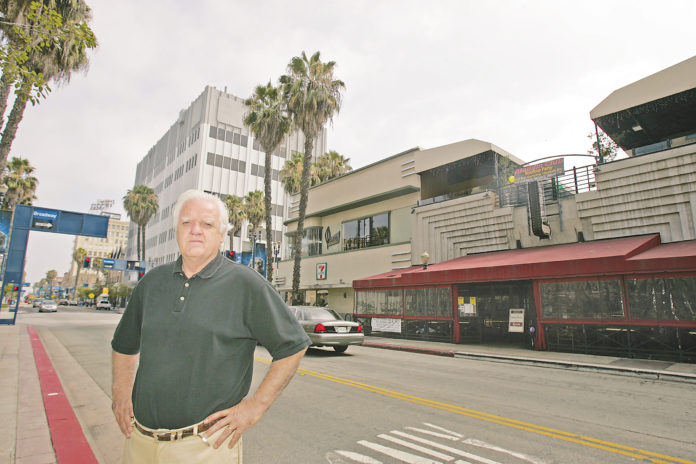After more than two decades on Long Beach’s Pine Avenue, John Morris said he’s ready to throw in the towel.
For years, the well-known local restaurateur has struggled to make a go of his establishments, first as proprietor of an upscale eatery called Mum’s, then with the more modest Smooth’s Sports Grill at the same location.
After a brief period during which his eateries flourished, his battle to succeed in the city’s historic shopping and entertainment district has stalled. Four months ago, he laid off half his staff, stopped serving lunch, and closed Sundays and Mondays.
Now, Morris said, he’s “very close” to selling the place and relocating to the city’s tonier east side.
“I’m not going to lose any more money,” vowed Morris, 62. “It’s time to start another chapter, hopefully one that will put a smile on my face.”
He’s not alone. Up and down the once-crowded street, vacant storefronts have cropped up. Notable closures include clothing retailer Z Gallerie and Wasabi Japanese Restaurant. Diners once jostling for noontime tables have decidedly thinned out.
The downturn is being attributed to several factors. The bad economy has kept would-be patrons closer to home. And some merchants said that competition from a new shoreline development has siphoned off many customers.
The situation has grown so bad that merchants are squabbling with the local business improvement district. Downtown Long Beach Associates has been criticized for lacking a clear vision and even competing with merchants by holding events with discounted liquor sales.
“I think there’s a major disconnect between tenants and the DLBA,” Morris said.
The squabble is the latest in a history of problems on Pine Avenue, which from World War II though most of the 1970s was a bustling business and entertainment hub. But partly due to the downsizing of the Long Beach naval base, things went bust, inspiring a major redevelopment in the late 1980s.
Ten years ago, spurred by the arrival of new businesses and a resurgence of urban life in general, it seemed that the renaissance of Pine had been achieved, with new restaurants and clubs catering to hordes of visitors.
Then the Pike at Rainbow Harbor, a major dining and entertainment complex, opened in 2003 a few blocks away at the shore. The 369,000-square-foot development, with restaurants, nightclubs, movie theaters and hotel, was supposed to draw visitors from outside the city. However, many patrons shifted there from Pine. Hooters of Long Beach even moved to the Pike after noting that traffic on Pine was slowing. It has since reported a 20 percent increase in business.
Linda S. Congleton, a San Juan Capistrano-based retail consultant, said she is not sure that the Pike is to blame for all the problems. She noted that fewer people are taking business lunches, which has particularly hurt Pine and its stretch of posh eateries, including notable Italian restaurant L’Opera.
“Pine used to be a great place for business people to meet between Orange County and Los Angeles and I suspect that has diminished,” she said.
Carl Morgan, downtown project manager for the Long Beach Redevelopment Agency, blamed the broader economy.
“In general, we’ve been in a severe economic downturn that has impacted business – retail and restaurants – not only in Long Beach but elsewhere as well,” he said.
Internal fighting
Even so, some merchants claim, Downtown Long Beach Associates, to which they all pay dues, has made things worse. A key, unaddressed problem, they said, is parking along Pine, which is confusing and not well marked.
Earlier this month, the disagreements came to a head when the district canceled a planned beer garden during Funk Fest, a music festival featuring a dozen or so bands. Several local bars and restaurants said they couldn’t compete with the prices of beer at the event.
The merchants noted that the same issue arose in May during a street party kicking off the city’s annual Gay Pride Festival.
Ron Hodges, owner of downtown bar Shannon’s, said he doesn’t understand why the organization would undercut its members.
“They shouldn’t be competing,” he said.
The merchants’ unrest erupted last year into a petition signed by 70 downtown residents and 32 of the roughly 1,300 businesses represented by the organization that called for the association’s chief executive, Kraig Kojian, to step down. The petition claimed Kojian had been “dismissive, uncooperative, and unwilling to take the initiative necessary to implement improvements.”
Kojian declined to comment on the call for his resignation except to say the district’s directors had responded with a vote of confidence.
“I’m still here,” he said.
He maintained that the district is taking merchants’ criticism into account as it attempts to boost business, including working on signs to help direct visitors to available parking. Also, the organization is making efforts to better communicate and has increased promotional events from just three in 2007 to 13 the next year. Finally, the district is finishing a 20-year “community vision” plan to include extensive marketing, and street and landscaping improvements.
As evidence of progress, Kojian pointed to business occupancy rates between Ocean Boulevard and Sixth Street showing improvement: from 59 percent a year ago to 76 percent today.
“Every urban center has a Main Street and this is ours,” he said of Pine Avenue. “Traditionally and historically it’s been the core of our downtown.”

